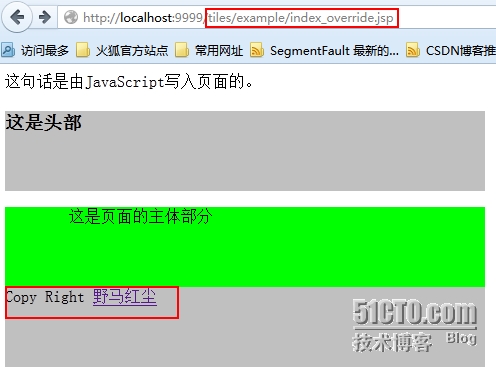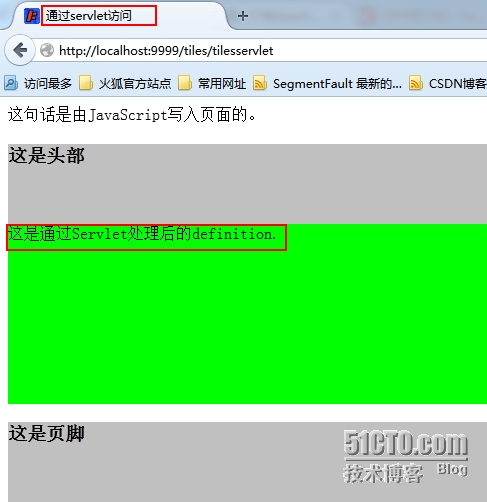使用Apache Tiles3.x构建界面布局
Tiles是一个免费的开源模板Java应用程序的框架。基于复合模式简化的用户界面的构建。对于复杂的网站仍是最简单、最优雅的方式与任何MVC技术一起工作。Struts2对Tiles提供了支持,如今Tiles发展已有13个年头,成为Apache的一个独立项目,我们可以单独使用Tiles来构建用户界面布局。
Tiles项目:http://tiles.apache.org/index.html
Tiles的配置DTD定义:http://tiles.apache.org/framework/tiles-core/dtddoc/index.html
本文主要通过构建一个简单的页面布局来认识Apache Tiles3.x(由于Tiles2.x和Tiles3.x存在较大差异)。
1.准备工作
1.1安装Apache Tiles3.x依赖的Jar
|
1
2
3
4
5
6
7
8
9
10
11
12
13
14
15
|
<dependency> <groupId>org.apache.tiles</groupId> <artifactId>tiles-extras</artifactId> <version>3.0.5</version> </dependency> <dependency> <groupId>org.apache.tiles</groupId> <artifactId>tiles-servlet</artifactId> <version>3.0.5</version> </dependency> <dependency> <groupId>org.apache.tiles</groupId> <artifactId>tiles-jsp</artifactId> <version>3.0.5</version> </dependency> |
注意:这里使用了Apache3.x完整包依赖。
1.2调试环境
安装jetty-maven-plugin来热部署web应用
|
1
2
3
4
5
6
7
8
9
10
11
12
13
14
15
16
17
|
<build> <finalName>tiles</finalName> <plugins> <plugin> <groupId>org.mortbay.jetty</groupId> <artifactId>jetty-maven-plugin</artifactId> <version>7.1.6.v20100715</version> <configuration> <scanIntervalSeconds>1</scanIntervalSeconds> <reload>automatic</reload> <webAppConfig> <contextPath>/tiles</contextPath> </webAppConfig> </configuration> </plugin> </plugins> </build> |
注意:运行mvn jetty:run -Djetty.port=9999 命名,访问http://localhost:9999/tiles 需要额外在Maven的settings.xml文件的插件组中添加插件组标识。
|
1
2
3
4
5
6
7
|
<pluginGroups> <!-- pluginGroup | Specifies a further group identifier to use for plugin lookup. <pluginGroup>com.your.plugins</pluginGroup> --> <pluginGroup>org.mortbay.jetty</pluginGroup> </pluginGroups> |
1.3配置web.xml
在web.xml中添加Tiles监听器
|
1
2
3
|
<listener> <listener-class>org.apache.tiles.extras.complete.CompleteAutoloadTilesListener</listener-class> </listener> |
关于Tiles的监听器可以自定义实现,参见:http://tiles.apache.org/framework/config-reference.html
2.分析界面组成,构建布局文件
假设本案例中的页面构成如图:

分析界面布局,找不通用部分,特殊部分。 在webapp下创建layout文件夹放在布局文件,snippet文件夹放置公共部分。
通过分析,将布局切割为header,body,footer,并且将HTML页面中的meta,script公共部分抽取出来。
/snippet/meta.jsp
|
1
2
3
|
<%@ page language="java" contentType="text/html; charset=UTF-8" pageEncoding="UTF-8"%><meta http-equiv="Content-Type" content="text/html; charset=UTF-8"> |
/snippet/script.jsp
|
1
2
3
4
5
6
7
8
9
10
11
12
13
14
15
16
17
|
<%@ page language="java" contentType="text/html; charset=UTF-8" pageEncoding="UTF-8"%><style>div { width: 480px; height: 80px; background: silver;}#body { background: lime;}</style><script type="text/javascript"> document.writeln("这句话是由JavaScript写入页面的。");</script> |
/snippet/header.jsp
|
1
2
3
4
5
|
<%@ page language="java" contentType="text/html; charset=UTF-8" pageEncoding="UTF-8"%><h3>这是头部</h3> |
/snippet/footer.jsp
|
1
2
3
|
<%@ page language="java" contentType="text/html; charset=UTF-8" pageEncoding="UTF-8"%><h3>这是页脚</h3> |
/snippet/index_body.jsp
|
1
2
3
4
5
|
<%@ page language="java" contentType="text/html; charset=UTF-8" pageEncoding="UTF-8"%><pre> 这是页面的主体部分</pre> |
通过上面的公共部分和主体,构建一个布局文件如下:
/layout/index_layout.jsp
|
1
2
3
4
5
6
7
8
9
10
11
12
13
14
15
16
17
18
19
20
21
22
23
|
<%@ page language="java" contentType="text/html; charset=UTF-8" pageEncoding="UTF-8"%><%@ taglib uri="http://java.sun.com/jsp/jstl/core" prefix="c"%><%@ taglib uri="http://tiles.apache.org/tags-tiles" prefix="tiles"%><!DOCTYPE html><html><head><tiles:insertAttribute name="meta" /><title><tiles:insertAttribute name="title" /></title><tiles:insertAttribute name="script" /></head><body> <div id="header"> <tiles:insertAttribute name="header" /> </div> <div id="body"> <tiles:insertAttribute name="body" /> </div> <div id="footer"> <tiles:insertAttribute name="footer" /> </div></body></html> |
3.Tiles的复合布局定义
Tiles是通过在xml文件中配置definition进行页面公共部分的重用,页面布局的组合。
/WEB-INF/tiles-defs.xml 定义好公共部分之后,通过配置definition来组合页面布局。
|
1
2
3
4
5
6
7
8
9
10
11
12
13
14
|
<?xml version="1.0" encoding="UTF-8" ?><!DOCTYPE tiles-definitions PUBLIC "-//Apache Software Foundation//DTD Tiles Configuration 3.0//EN" "http://tiles.apache.org/dtds/tiles-config_3_0.dtd"><!-- Definitions for Tiles documentation --><tiles-definitions> <definition name="tiles.base.definition"> <put-attribute name="meta" value="/snippet/meta.jsp" /> <put-attribute name="script" value="/snippet/script.jsp" /> <put-attribute name="header" value="/snippet/header.jsp" /> <put-attribute name="footer" value="/snippet/footer.jsp" /> </definition></tiles-definitions> |
上面的definition可以说是抽象的,仅仅作为基本的定义抽取了界面中最通用的部分,而且并未指定具体的模版文件(布局文件)。下面通过继承tiles.base.definition来定一个tiles.index.definition其布局模版为/layout/index_layout.jsp。
|
1
2
3
4
|
<definition name="tiles.index.definition" extends="tiles.base.definition" template="/layout/index_layout.jsp"> <put-attribute name="body" value="/snippet/index_body.jsp" /> </definition> |
上面定义tiles.index.definition,新增了body,其值为/snippet/index_body.jsp页面。
4.使用复合布局
到这里已经将页面的布局进行了分割,组合。现在应用definition来构建一个请求响应页面。
/example/index.jsp
|
1
2
3
4
5
6
|
<%@ page language="java" contentType="text/html; charset=UTF-8" pageEncoding="UTF-8"%><%@ taglib uri="http://tiles.apache.org/tags-tiles" prefix="tiles"%><tiles:insertDefinition name="tiles.index.definition"> <tiles:putAttribute name="title" value="这是一个有Apache Tiles构建的页面布局." /></tiles:insertDefinition> |
5.启动服务器,访问/example/index.jsp
页面展示效果:

接下来看看页面的源代码:
|
1
2
3
4
5
6
7
8
9
10
11
12
13
14
15
16
17
18
19
20
21
22
23
24
25
26
27
28
29
30
31
32
33
34
35
36
37
38
39
40
41
42
|
<!DOCTYPE html><html><head><meta http-equiv="Content-Type" content="text/html; charset=UTF-8"><title>这是一个有Apache Tiles构建的页面布局.</title><style>div { width: 480px; height: 80px; background: silver;}#body { background: lime;}</style><script type="text/javascript"> document.writeln("这句话是由JavaScript写入页面的。");</script></head><body> <div id="header"> <h3>这是头部</h3> </div> <div id="body"> <pre> 这是页面的主体部分</pre> </div> <div id="footer"> <h3>这是页脚</h3> </div></body></html> |
该例子中布局index_layout.jsp中body是可变的,title对一个不同的页面有不同的标题设置。在tiles-defx.xml的tiles.index.definition继承了tiles.base.definition,并且添加了其body页面,接着在插入tiles.index.definition的index.jsp页面添加了title。这样做达到的效果是整个站点的header,footer,meta,script抽取到了一个definition,然后通过继承的方式进行扩展,丰富不同的布局的页面组成元素,在具体的响应页面来定义专属该页面的内容。从而达到对页面的布局的控制,公共部分的复用的效果。
6.总结
本文仅仅是一个简单的示例,然而大部分内容被抽取公共部分占去,这样的结果并非意外,对于页面布局的划分,组合,重用才是使用Tiles之前最为繁重和复杂的工作,这些工作能够做的合理,优雅,配置definition自然就轻松多了。
http://aiilive.blog.51cto.com/1925756/1596059
接着上一篇:使用Apache Tiles3.x构建界面布局(一)继续构建页面布局。
上一篇示例中已经对页面的公共部分进行了抽取,创建了布局,并且将使用的布局应用的响应页面了。
1.定义definition来改变公共部分
现在有个新变化,响应页面的footer部分需要发生点变化,这个时候仍然可以通过继承的方式来配置一个definition。
/WEB-INF/tiles-defs.xml 中新增definition
|
1
2
3
4
|
<definition name="tiles.override.definition" extends="tiles.index.definition"> <put-attribute name="footer" value="Copy Right <a href='http://aiilive.blog.51cto.com'>野马红尘</a>"></put-attribute> </definition> |
1.1创建响应页面/example/index_override.jsp
|
1
2
3
4
5
6
|
<%@ page language="java" contentType="text/html; charset=UTF-8" pageEncoding="UTF-8"%><%@ taglib uri="http://tiles.apache.org/tags-tiles" prefix="tiles"%><tiles:insertDefinition name="tiles.override.definition"> <tiles:putAttribute name="title" value="这是一个有Apache Tiles构建的页面布局." /></tiles:insertDefinition> |
1.2访问:/tiles/example/index_override.jsp

注意:footer部分发生了改变,使用了tiles.override.definition的footer属性。
2.响应页面中定义body
/example/home.jsp
|
1
2
3
4
5
6
7
8
9
10
11
12
13
14
15
16
|
<%@ page language="java" contentType="text/html; charset=UTF-8" pageEncoding="UTF-8"%><%@ taglib uri="http://tiles.apache.org/tags-tiles" prefix="tiles"%><tiles:insertDefinition name="tiles.index.definition"> <tiles:putAttribute name="title" value="HOME 页面." /> <tiles:putAttribute name="body"> <h3>这是HOME页面的body</h3> <ul> <li>Apache Tiles</li> <li>Sitemesh</li> <li>Smarty</li> <li>Freemarker</li> <li>Velocity</li> </ul> </tiles:putAttribute></tiles:insertDefinition> |
访问:/tiles/example/home.jsp

3.通过Servlet来访问definition(tiles.index.definition),可编程式!
|
1
2
3
4
5
6
7
8
9
10
11
12
13
14
15
16
17
18
19
20
21
22
23
24
25
26
27
28
29
30
31
32
33
34
35
36
37
38
39
40
41
42
43
44
45
46
47
48
49
50
51
|
package secondriver.tiles.servlet;import java.io.IOException;import javax.servlet.ServletException;import javax.servlet.http.HttpServlet;import javax.servlet.http.HttpServletRequest;import javax.servlet.http.HttpServletResponse;import org.apache.tiles.Attribute;import org.apache.tiles.Definition;import org.apache.tiles.TilesContainer;import org.apache.tiles.access.TilesAccess;import org.apache.tiles.request.ApplicationContext;import org.apache.tiles.request.Request;import org.apache.tiles.request.servlet.ServletRequest;import org.apache.tiles.request.servlet.ServletUtil;public class TilesServlet extends HttpServlet { private static final long serialVersionUID = 2721434552222217027L; @Override protected void service(HttpServletRequest request, HttpServletResponse response) throws ServletException, IOException { ApplicationContext applicationContext = ServletUtil .getApplicationContext(getServletContext()); TilesContainer container = TilesAccess.getContainer(applicationContext); Request currentRequest = new ServletRequest(applicationContext, request, response); Definition definition = container.getDefinition( "tiles.index.definition", currentRequest); definition.putAttribute("title", new Attribute("通过servlet访问")); definition.putAttribute("body", new Attribute( "这是通过Servlet处理后的definition.")); container.render(definition, currentRequest); /** * 不需要处理的时候可以直接使用definition的name * * tiles.index.definition没有定义title属性 * * 而template文件(布局)中用到所以需要在Servlet中进行添加 */ // container.render("tiles.index.definition", currentRequest); }} |
访问:/tiles/tilesservlet

注意:
这里使用了Servlet需要在web.xml中增加Servlet的配置
|
1
2
3
4
5
6
7
8
|
<servlet> <servlet-name>tilesservlet</servlet-name> <servlet-class>secondriver.tiles.servlet.TilesServlet</servlet-class> </servlet> <servlet-mapping> <servlet-name>tilesservlet</servlet-name> <url-pattern>/tilesservlet</url-pattern> </servlet-mapping> |
在pom.xml中添加servlet-api:
|
1
2
3
4
5
|
<dependency> <groupId>javax.servlet</groupId> <artifactId>servlet-api</artifactId> <version>2.5</version> </dependency> |
4.通过标签在响应页面上配置definition,并插入到页面中
|
1
2
3
4
5
6
7
8
9
10
11
12
13
|
<%@ page language="java" contentType="text/html; charset=UTF-8" pageEncoding="UTF-8"%><%@ taglib uri="http://tiles.apache.org/tags-tiles" prefix="tiles"%><tiles:definition name="tiles.runtime.definiation" template="/layout/index_layout.jsp" extends="tiles.base.definition"> <tiles:putAttribute name="title" value="通过标签配置 definition." /> <tiles:putAttribute name="body"> 通过tiles标签配置的运行时definition </tiles:putAttribute></tiles:definition><tiles:insertDefinition name="tiles.runtime.definiation"></tiles:insertDefinition> |
访问:/tiles/example/runtime.jsp

本文通过多种方式展示了Tiles的使用和其灵活性。另外Tiles还可以和Freemarker,Velocity,Spring,Struts等多种框架集成使用。
具体可以参考官方文档:http://tiles.apache.org/framework/whats-new.html。
另外更多的示例:http://tiles.apache.org/download.html
http://aiilive.blog.51cto.com/1925756/1596069
使用Apache Tiles3.x构建界面布局的更多相关文章
- 使用 Apache Tiles 3 构建页面布局
参考博客:http://aiilive.blog.51cto.com/1925756/1596059Apache Tiles是一个JavaEE应用的页面布局框架.Tiles框架提供了一种模板机制,可以 ...
- 微信js框架第二篇(创建完整界面布局)
接着昨天的继续谈关于微信新出的这个js框架,今天主要谈一个页面的创建到布局的详细步骤. 一.创建一个完整页面 页面你可以创建在项目的任何节点,只要你在入口文件正确引入创建该页面的路径就可使 ...
- 2013 duilib入门简明教程 -- 界面布局(9)
上一个教程实现的标题栏代码中,并没有看到处理自适应窗口大小的代码,但是窗口大小变化后,按钮的位置会跟着变化,这是因为我们将按钮放到了HorizontalLayout.VerticalLayou ...
- php创建新用户注册界面布局实例
php创建新用户注册界面布局实例 <!DOCTYPE> <html> <head> <title>Load page</title> < ...
- WPF基础知识、界面布局及控件Binding(转)
WPF是和WinForm对应的,而其核心是数据驱动事件,在开发中显示的是UI界面和逻辑关系相分离的一种开放语言.UI界面是在XAML语言环境下开发人员可以进行一些自主设计的前台界面,逻辑关系还是基于c ...
- Unity 编辑器的 界面布局 保存方法
在软件界面的右上角(关闭按钮的下方),点击 layout (界面)的下拉箭头. 弹出选项中的 save layout....(保存界面选项),输入命名,就可以生成这个界面的布局. (软件本身也有 ...
- ios开发UI篇—使用纯代码自定义UItableviewcell实现一个简单的微博界面布局
本文转自 :http://www.cnblogs.com/wendingding/p/3761730.html ios开发UI篇—使用纯代码自定义UItableviewcell实现一个简单的微博界面布 ...
- iOS开发UI篇—使用xib自定义UItableviewcell实现一个简单的团购应用界面布局
iOS开发UI篇—使用xib自定义UItableviewcell实现一个简单的团购应用界面布局 一.项目文件结构和plist文件 二.实现效果 三.代码示例 1.没有使用配套的类,而是直接使用xib文 ...
- UWP开发入门(二十)——键盘弹起时变更界面布局
UWP APP在键盘弹起或隐藏时,并不会自动处理界面布局.有时会出现键盘遮挡了下一个需要填写的文本框,或是下一步按钮的情况.本篇我们以登录界面做例子,用一种巧妙简单的方式在键盘弹起和隐藏时更改界面的布 ...
随机推荐
- java中的switch用String作为条件
在开发java程序的过程中,我们遇到了条件推断首选就是switch,可是java中的switch功能不支持字符串作为条件.这时我们该怎么办呢? --使用枚举. 一.枚举简单了解 1.enum是一 ...
- 从零开始使用git第二篇:git的日常操作
从零开始使用git 第二篇:git的日常操作 第一篇:从零开始使用git第一篇:下载安装配置 第二篇:从零开始使用git第二篇:git实践操作 第三篇:从零开始使用git第三篇:git撤销操作.分支操 ...
- thinkphp3.1课程 1-1 为什么thinkphp在开发好后需要关掉开发模式
thinkphp3.1课程 1-1 为什么thinkphp在开发好后需要关掉开发模式 一.总结 一句话总结:因为调试模式中会记录你所有的调试信息,比如a调用b,b调用c,c调用d,比如你从哪个数据库取 ...
- PHP Filesystem 函数(文件系统函数)(每日一课的内容可以从php参考手册上面来)
PHP Filesystem 函数(文件系统函数)(每日一课的内容可以从php参考手册上面来) 一.总结 1.文件路径中的正反斜杠:当在 Unix 平台上规定路径时,正斜杠 (/) 用作目录分隔符.而 ...
- poj1564 Sum It Up (zoj 1711 hdu 1258) DFS
POJhttp://poj.org/problem?id=1564 ZOJhttp://acm.zju.edu.cn/onlinejudge/showProblem.do?problemId=711 ...
- 【p092】分数线划定
Time Limit: 1 second Memory Limit: 128 MB [问题描述] 世博会志愿者的选拔工作正在A市如火如荼地进行.为了选拔最合适的人才,A市对所有报名的选手进行了笔试,笔 ...
- python中有关字符串的处理
原文 Python 字符串操作(string替换.删除.截取.复制.连接.比较.查找.包含.大小写转换.分割等) 去空格及特殊符号 s.strip().lstrip().rstrip(',') 复制字 ...
- Yii Framework2.0开发教程(1)配置环境及第一个应用HelloWorld
准备工作: 我用的开发环境是windows下的apache+mysql+php 编辑器不知道该用哪个好.临时用dreamweaver吧 我自己的http://localhost/相应的根文件夹是E:/ ...
- Mahout快速入门教程 分类: B10_计算机基础 2015-03-07 16:20 508人阅读 评论(0) 收藏
Mahout 是一个很强大的数据挖掘工具,是一个分布式机器学习算法的集合,包括:被称为Taste的分布式协同过滤的实现.分类.聚类等.Mahout最大的优点就是基于hadoop实现,把很多以前运行于单 ...
- div宽度设置width:100%后再设置padding或margin超出父元素的解决办法
div宽度设置width:100%后再设置padding或margin超出父元素的解决办法 一.总结 一句话总结:直接加上box-sizing:border-box;即可解决上述问题. 1.box-s ...
